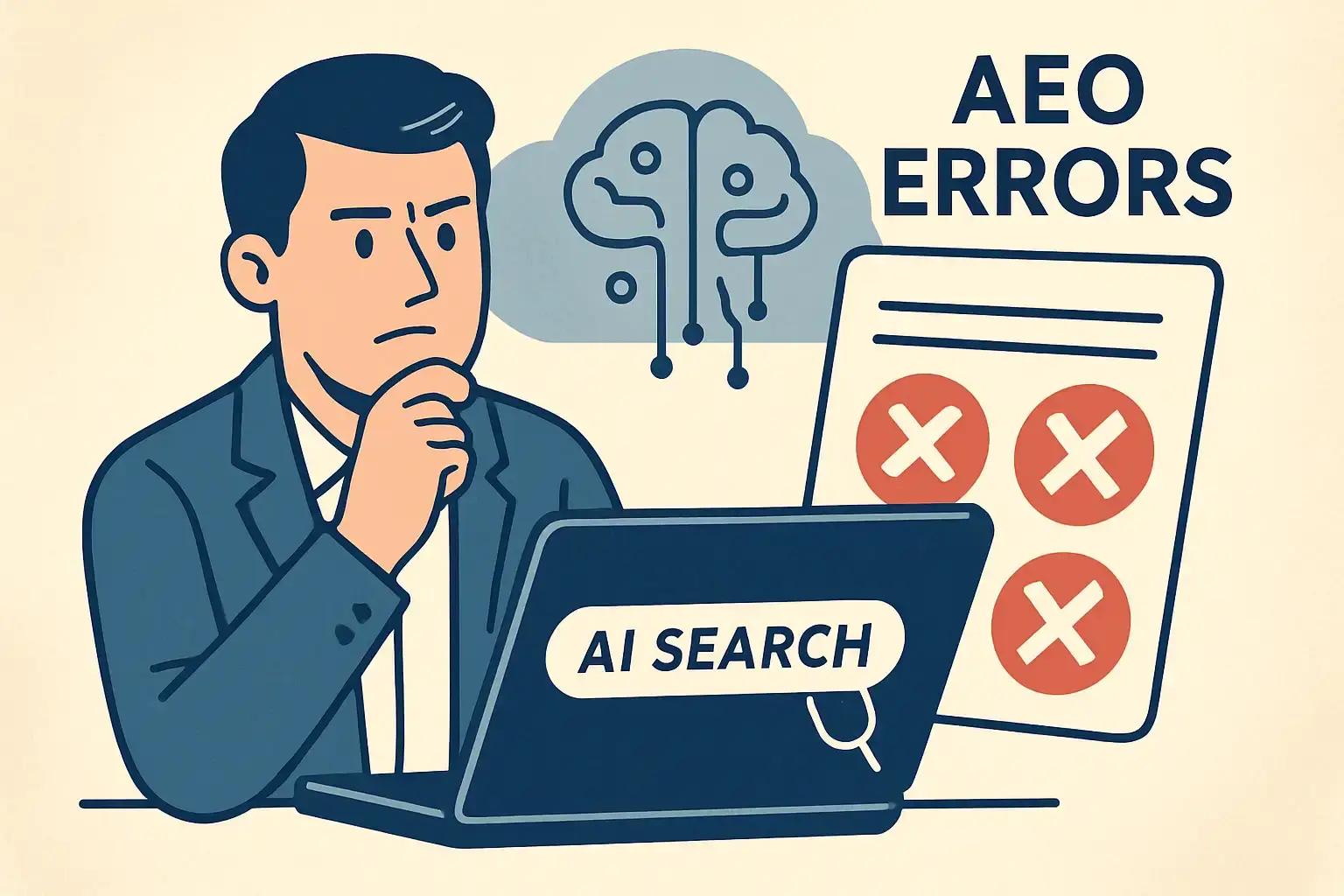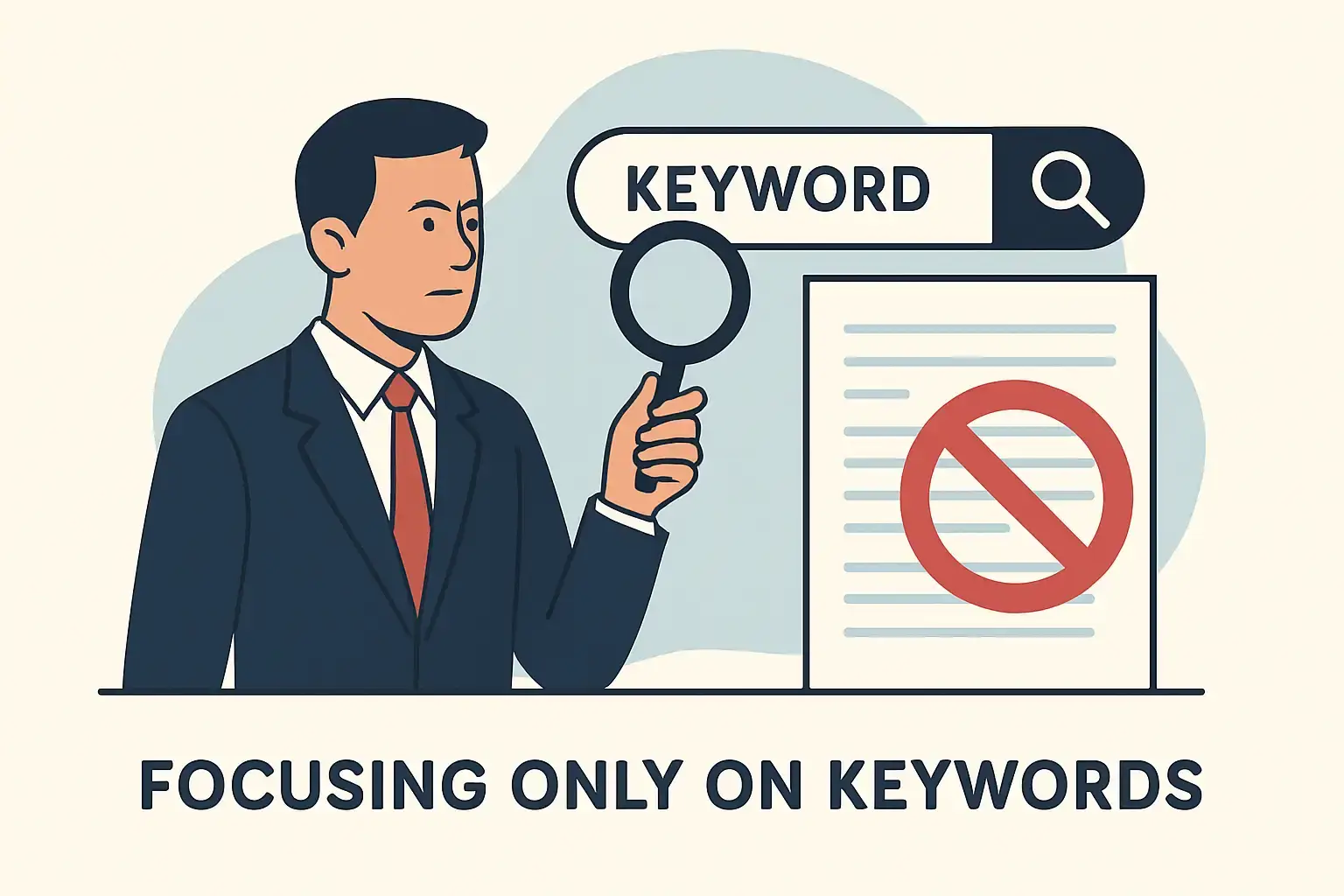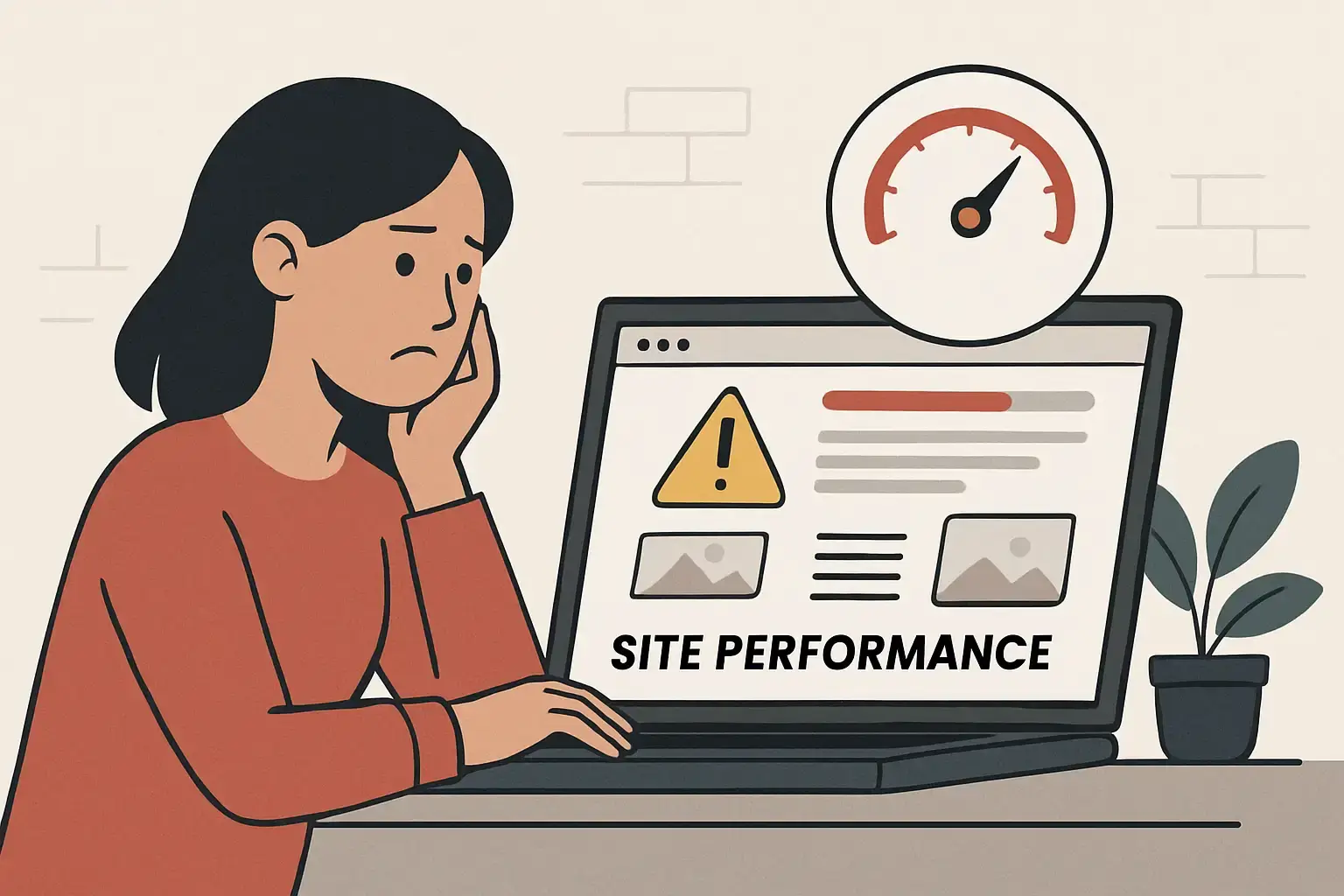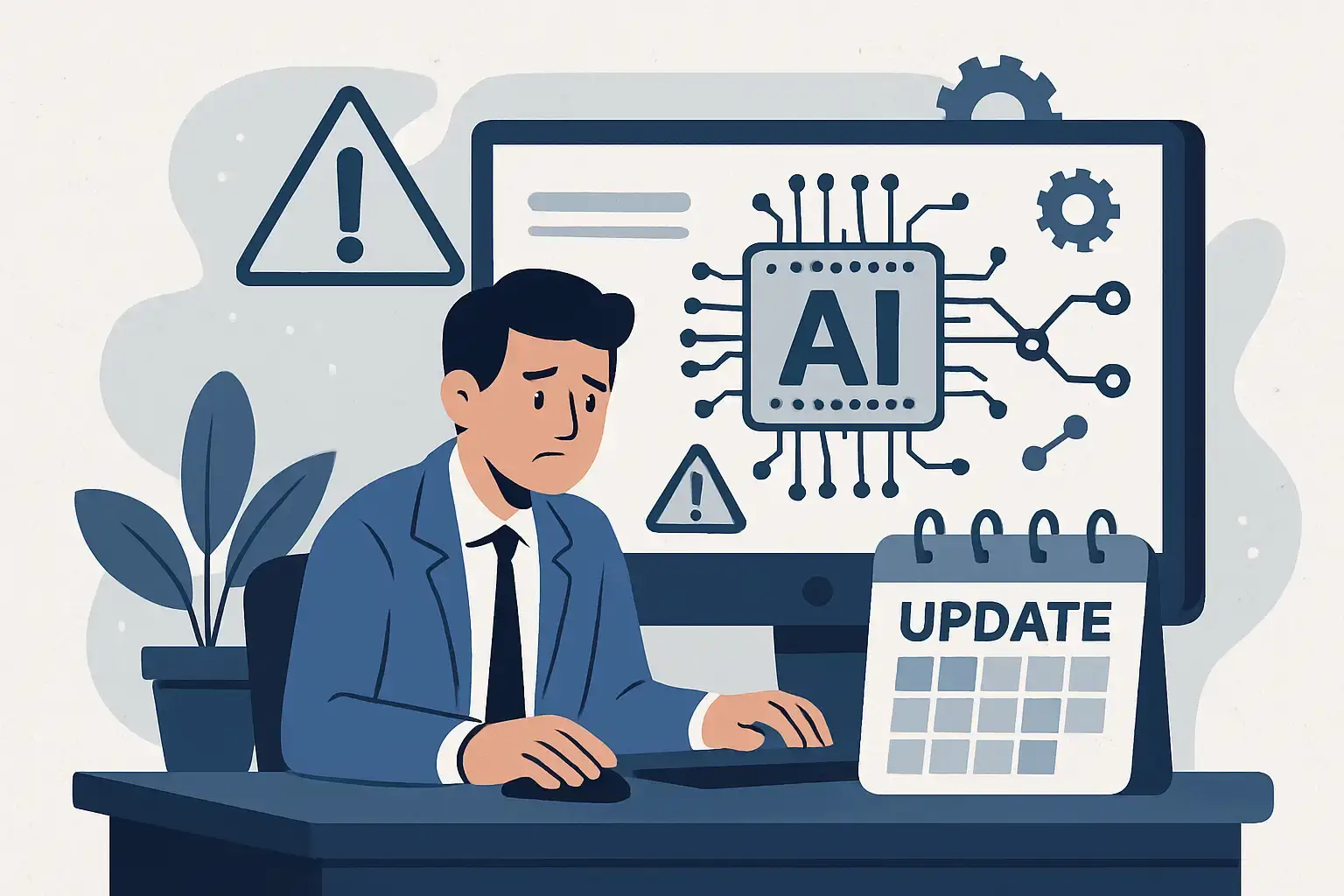How to Optimize for AI Search: Avoid Common AEO Errors

TL;DR — To effectively optimize for AI search, it's crucial to understand user intent, utilize structured data and schema markup, focus on context rather than just keywords, ensure your site has strong technical SEO and performance, and stay updated with evolving AI algorithms. Following these AEO best practices and avoiding common errors can significantly improve your AI search ranking and visibility, helping you avoid AI search penalties and solve ai search ranking problems.
Table of Contents
1. Overlooking User Intent in Content Creation
When you're optimizing for AI search, understanding user intent is your secret weapon. But what exactly does that mean? In simple terms, user intent is the real reason behind a search query—the goal the user wants to achieve. AI search engines don’t just look for keywords anymore; they try to figure out if someone wants to learn something, buy a product, compare options, or solve a problem.
Why User Intent Matters More Than Keywords
Imagine you’re searching for "best running shoes." Are you looking for reviews, a place to buy, or maybe tips on choosing the right pair? AI search engines want to deliver exactly what you need, not just pages stuffed with the phrase "running shoes." If your content misses the mark on intent, it’s like showing up to a party wearing the wrong outfit—you won’t get the attention you want.
The Cost of Ignoring User Intent
If you focus only on keywords without addressing what users truly want, your AEO efforts can take a hit. Here’s what might happen:
- Lower rankings: AI search engines prioritize content that matches intent, so your pages might get pushed down.
- Reduced click-through rates: Even if your page appears, it won’t attract clicks if it doesn’t answer the user’s question.
- Fewer conversions: Visitors who don’t find what they need quickly will bounce, hurting your business goals.
Tip: To nail user intent, start by analyzing the types of queries your audience uses. Are they informational, transactional, or navigational? Tailor your content to meet those specific needs rather than just sprinkling in keywords.
By aligning your content with user intent, you’re not just optimizing for AI—you’re creating a better experience for your visitors. And that’s a win-win in today’s search landscape.
2. Neglecting Structured Data and Schema Markup

If you want AI search engines to truly understand your content, structured data is your best friend. Think of it as giving the AI a clear, organized map of what your page is about. Without it, your content might get lost in translation, and you could miss out on those valuable rich snippets or voice search features that grab attention.
Why Structured Data Matters for AI Search Engines
Structured data uses schema markup—a standardized vocabulary—to label your content. This helps AI not just read your page, but comprehend it. For example, if you run an e-commerce site, schema can tell AI exactly which parts are product names, prices, reviews, or availability. This clarity can lead to enhanced search results like:
- Rich snippets with star ratings and pricing
- Knowledge panels that summarize your business
- Voice search answers that sound natural and accurate
By adding schema markup, you’re essentially speaking the AI’s language, which boosts your chances of ranking higher and getting noticed.
Common Schema Markup Mistakes to Avoid
Even if you’re convinced about using structured data, it’s easy to slip up. Here are the most frequent errors that can hurt your AEO efforts:
|
Mistake |
Why It’s a Problem |
How to Fix It |
|---|---|---|
|
Using incorrect or outdated schema |
AI can’t interpret your content properly |
Always use the latest schema.org types |
|
Missing required properties |
Incomplete data confuses AI and reduces benefits |
Double-check required fields for each type |
|
Marking up invisible content |
Seen as deceptive, can lead to penalties |
Only markup content visible to users |
|
Syntax errors or invalid JSON-LD |
Schema won’t be read or will cause errors |
Use tools like Google’s Structured Data Testing Tool |
|
Overstuffing schema markup |
Can confuse AI and dilute relevance |
Keep markup relevant and concise |
Pro tip: Regularly validate your structured data with tools like Google’s Rich Results Test. It’s a quick way to catch errors before they impact your rankings.
By avoiding these pitfalls, you ensure your structured data works for you, not against you. Remember, the goal is to make your content crystal clear to AI, so it can confidently feature you in those coveted AI-driven search results.
3. Focusing Only on Keywords Instead of Context

If you’re still thinking about SEO as just a game of keyword stuffing, it’s time to shift gears. AI search engines don’t just scan for exact words anymore—they’re smart enough to understand what you really mean. Instead of matching keywords, AI digs into the context, the overall meaning, and the intent behind your content.
How AI Search Interprets Content Differently
Traditional search engines mainly look for keywords and try to match them with what’s in their index. But AI search? It’s a whole different ballgame. It uses natural language processing and machine learning to:
- Understand synonyms and related terms
- Grasp the relationships between concepts
- Analyze the user’s intent behind a query
- Summarize and generate relevant answers
This means AI can deliver more precise, helpful results rather than just a list of pages containing your keywords.
Tip: Instead of repeating the same keyword, try using related phrases and answering common questions around your topic. This helps AI see your content as a comprehensive resource.
Why Context Beats Keywords in AEO
When you focus only on keywords, you risk creating content that feels forced or shallow. AI search engines want to understand the full picture—the topic, the nuances, and how your content fits the user’s needs. That’s why context matters more than ever.
By providing rich, well-structured content that covers related ideas and answers multiple questions, you signal to AI that your page is authoritative and relevant. This approach not only improves your rankings but also enhances the user experience.
|
Keyword-Focused SEO |
Context-Focused AEO |
|---|---|
|
Repeats exact keywords frequently |
Uses synonyms and related concepts |
|
Targets isolated phrases |
Addresses broader topics and questions |
|
Optimizes for search engines only |
Optimizes for user intent and meaning |
Remember, AI is designed to think like a human reader. So, write your content like you’re explaining something valuable to a friend—not just ticking off keyword boxes. This mindset will help you avoid one of the biggest mistakes in AI search optimization.
4. Ignoring Site Performance and Technical SEO

When it comes to AI search rankings, site speed and technical SEO aren’t just nice-to-haves—they’re essential. AI-driven search engines prioritize user experience signals, and a fast-loading, technically sound site tells them you care about your visitors. If your pages drag or your site’s structure confuses crawlers, you’re sending the wrong signals, which can tank your rankings.
Why Site Speed and Technical SEO Matter for AI Search
AI search engines interpret user engagement as a quality indicator. Fast pages reduce bounce rates and keep visitors exploring your content longer. On the flip side, slow load times frustrate users and increase the chance they’ll click away—something AI definitely notices.
Technical SEO ensures AI can efficiently crawl, index, and understand your site. This includes:
- Mobile-friendliness: Most searches happen on mobile, so your site must look and work great on any device.
- Secure connections (HTTPS): Security is a trust factor for both users and AI.
- Proper indexing and crawlability: Robots.txt and sitemap files guide AI bots to your important pages.
- Structured data: Helps AI grasp your content context and display rich results.
Ignoring these can leave your site invisible or misunderstood by AI search engines.
Common Technical Issues That Trip Up AEO
Here are the usual suspects that can sabotage your Answer Engine Optimization efforts:
|
Issue |
Why It Matters |
|---|---|
|
Slow page load times |
Leads to higher bounce rates and lower rankings |
|
Broken links or 404 errors |
Interrupts user experience and confuses crawlers |
|
Poor mobile optimization |
Limits accessibility for the majority of users |
|
Missing/incorrect robots.txt or sitemap |
Prevents proper crawling and indexing |
|
Duplicate content & bad canonical tags |
Causes confusion about which page to rank |
|
Incomplete/incorrect structured data |
AI can’t fully understand or showcase your content |
|
Lack of HTTPS |
Reduces trust and security signals |
Pro tip: Use tools like Google PageSpeed Insights to regularly audit your site’s technical health. Fixing even a few of these issues can boost your AI search visibility significantly.
By keeping your site fast, secure, and technically sound, you’re not just avoiding mistakes—you’re setting yourself up to win in the AI search game.
5. Forgetting to Update and Optimize for Evolving AI Algorithms

AI search algorithms aren’t static—they’re constantly evolving. Sometimes these changes happen monthly or even more frequently as developers fine-tune how AI understands natural language, detects user intent, and ranks content. Why does this matter to you? Because what worked well yesterday might not cut it today. If you don’t keep up, your site’s visibility can slip without you even realizing it.
Why Frequent Updates Matter
AI’s rapid evolution means your SEO and AEO strategies need to be just as dynamic. When algorithms shift, the way AI interprets your content changes, which can impact your rankings. Ignoring these updates is like trying to navigate with an outdated map—you might end up off course.
How to Stay Ahead: Practical Steps
Here’s a straightforward checklist to keep your site optimized as AI algorithms evolve:
-
Monitor Search Performance and Algorithm Updates
Keep an eye on your analytics and industry news. Tools like Google Search Console and SEO forums can alert you to shifts in rankings or algorithm changes. -
Audit and Refresh Your Content Regularly
Make sure your content still matches what users are searching for. Update it to cover new questions, add fresh insights, and improve clarity. -
Maintain Structured Data Markup
Structured data helps AI understand your content better. Keep your schema markup accurate and up to date to boost your chances of appearing in rich results. -
Optimize Technical SEO
Don’t overlook site speed, mobile usability, and security. These factors influence AI’s ranking decisions and user experience alike. -
Stay Informed on AI Search Trends
Follow trusted industry blogs, attend webinars, and participate in SEO communities to learn about emerging best practices. -
Test and Adapt Based on Data
Use A/B testing and performance metrics to see what works. Be ready to pivot your strategies as new data comes in.
Pro tip: According to recent SEO surveys, sites that update their content regularly tend to see significant improvements in search rankings. Content freshness is key—Google's Freshness Algorithm rewards websites that consistently update their content, provided it remains timely and relevant. Regular updates aren’t just good practice—they’re essential.
By treating your SEO and AEO efforts as ongoing projects rather than one-time tasks, you’ll keep your site aligned with AI’s evolving expectations. Remember, staying flexible and proactive is your best defense against ranking drops.
Keep adapting, and you’ll not only avoid common pitfalls but also position your site for long-term success in the AI search era. You’ve got this!
Frequently Asked Questions (FAQ)
What are the most common AI search optimization mistakes to avoid?
The most common AI search optimization mistakes include neglecting user intent, ignoring structured data and schema markup, focusing solely on keywords instead of context, overlooking site performance and technical SEO, and failing to update strategies for evolving AI algorithms. Avoiding these errors is essential for improving your AI search rankings.
How can I improve my site’s ranking in AI search results?
To improve your site’s ranking in AI search results, focus on understanding and aligning with user intent, implement structured data and schema markup correctly, create content that emphasizes context over keywords, optimize your site’s technical SEO and speed, and stay informed about AI algorithm updates to adapt your strategies accordingly.
Why isn't my site ranking well in AI search?
If your site isn't ranking well in AI search, it could be due to ai search ranking problems such as poor understanding of user intent, lack of structured data, over-reliance on keywords, technical SEO issues, or outdated optimization strategies. Conducting an audit and following this ai search optimization guide can help identify and fix these issues.
What are some best practices for AI search SEO?
Best practices for AI search SEO include analyzing user intent, using schema markup and structured data, focusing on content context and relevance, ensuring fast site performance and mobile optimization, and regularly updating your content and technical SEO to keep pace with AI algorithm changes.
How do I stay ahead with AI search optimization?
To stay ahead with AI search optimization, monitor search performance and algorithm updates, regularly audit and refresh your content, maintain accurate structured data, optimize technical SEO, follow industry trends, and adapt your strategies based on data insights. This proactive approach helps avoid ai search penalties and enhances your rankings.
